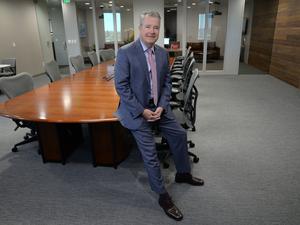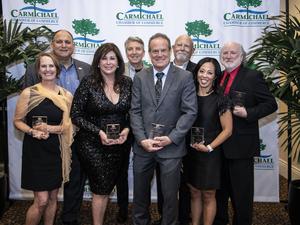The Sacramento Municipal Utility District plans to invest about $4.5 billion to decarbonize its energy supply by 2030, the most aggressive plan by a major utility in the country.
The plan isn’t just net-carbon zero. It calls for the elimination of the use of all fossil fuels by the district.
Beyond cleaning up its own carbon footprint as its piece of combating climate change, the SMUD effort is part of the utility’s ongoing effort over decades to improve air quality in the Sacramento air basin, especially in neighborhoods in historically low-income areas. Sacramento ranks as one of the dirtiest air basins in the country.
A key part of SMUD’s plan is to do all of this work in just less than eight years while also holding down rates for customers. To that end, many of SMUD’s upgrades are long-term contracts to buy power from investors that will pay the upfront cost of building or delivering the clean power.
“Wind, solar, emerging battery storage systems and geothermal resources are the types of investments we will pursue to achieve a clean energy future that leaves no community behind,” said SMUD CEO Paul Lau. The SMUD plan would achieve zero-carbon electricity 15 years ahead of the state’s deadline of 2045 to achieve a zero-carbon electricity system.
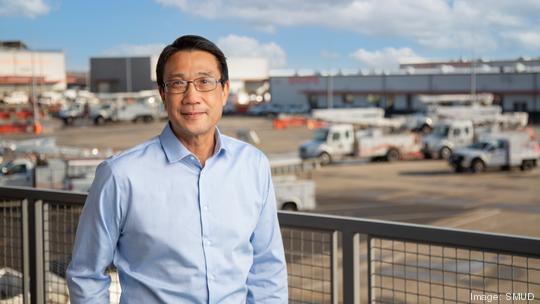
SMUD’s plans call for adding more solar, wind and geothermal resources to make the goal, while at the same time replacing natural gas generating plants that currently supply more than a quarter of the district’s peak electricity.
Replacing natural gas generating plants is tricky. Those natural gas plants are dependable sources of nearly instant power, so getting rid of them will be an ongoing challenge, especially in a hot climate like Sacramento, where peak power use during heat waves can already tax the regional grid. Paradoxically, SMUD’s natural gas plants are among the most efficient in the state, and most of them are paid off.
Counting on new technology
SMUD will be looking at alternative fuels for the largest of its natural gas-fired power plants, but renewable or biofuels for those plants are currently not yet readily available, said Lora Anguay, chief zero-carbon officer with SMUD.
The utility is preparing to test new technologies, strike up strategic partnerships and find creative ways to make its goal, Anguay said.
“The team took off running to meet this goal,” she said.
Even when SMUD first announced its 2030 zero-carbon goal a year ago, CEO Lau said that the utility knew it could get to 90% of the goal with existing technology, but that last 10% will rely on technology that has yet to be developed.
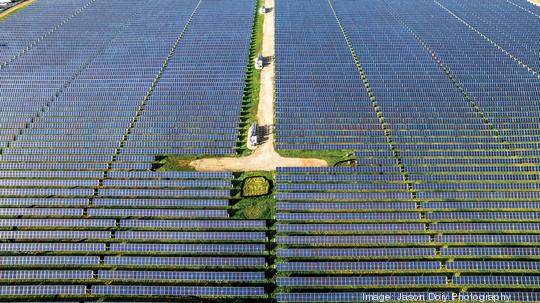
The first step of getting to the 2030 goal is set in motion for the next three years, and utility scale solar power will be doing a lot of the heavy lifting.
In just about three years, SMUD plans to more than double its entire total of utility scale solar arrays it has installed over 40 years. The utility currently has 444 megawatts of solar installed. In the next three years it plans to install nearly 600 megawatts more, Anguay said.
A megawatt is enough to power about 260 homes in California, which has the most energy efficient housing, according to the Solar Energy Industries Association.
Batteries will be a big deal in the future as well. While SMUD currently has just 4 megawatts of utility battery storage, in three years it plans to be at 269 megawatts of utility battery storage.
SMUD estimates that by 2030, it will have installed 3,000 megawatts of batteries and over 5,500 megawatts of solar generation.
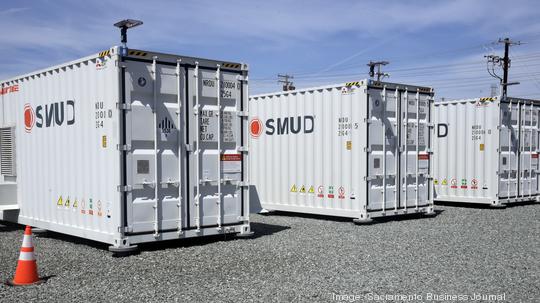
“Renewables have changed from being the most expensive to the least expensive source of electricity in just over a decade,” said Rob Kerth, a member of SMUD’s board of directors. “That’s how we can do this.”
SMUD is also going to increase its geothermal generation by more than 200% over the next three years. The utility earlier this year signed a 10-year power purchase agreement with Calpine Corp. for 100 megawatts of electricity per year from Calpine’s Geysers generating stations in Lake and Napa counties. SMUD currently gets about 49 megawatts from geysers.
Power purchase agreements, where the utility agrees to buy power for a period of time for a set rate, are some of the key ways SMUD is financing its moves. Rather than paying to build infrastructure, it’s willing to pay investors or companies over time for investments those companies have made. That’s how a utility with annual revenue of $1.8 billion in 2021 can afford to spend $4.5 billion over the next decade to get to zero carbon.
Earlier this year, New York-based D.E. Shaw Renewable Investments and SMUD agreed to a power purchase agreement where Shaw will finance and build a 200-megawatt solar farm in eastern Sacramento County. As part of the agreement, SMUD has committed to purchase power for 30 years. The Coyote Creek Agrivoltaic Ranch project will be the largest solar array in SMUD’s territory, covering 1,200 acres on a parcel that is over 2,550 acres.
Coyote Creek’s solar farm will be so large that it will take a crew of 10 people about 14 days to wash the solar panels. Washing dust and dirt off the panels a few times a year keeps them operating at higher efficiency.
For days without sun or wind
Coyote Creek will also eventually have 400 megawatts of battery storage on site.
Energy storage is one of the big challenges for a utility that depends on sun and wind to generate a great percentage of its power.
So SMUD is adding batteries, and it’s also considering making a giant battery out of some of its hydroelectric resources in the Sierra Nevada west of Lake Tahoe.
With 688 megawatts capacity, SMUD’s Upper American River Project has long been the backbone of the utility’s renewable resources. With a need to save excess electricity, SMUD is now considering teaching an old dog new tricks. SMUD is studying adding pumped storage at two of its powerhouses in the Sierra.
SMUD’s Union Valley Powerhouse can generate 46.7 megawatts. The existing Jones Fork Powerhouse, also on the Union Valley Reservoir, has a capacity of 11.5 megawatts. It is also operated as a peaking power plant.
Converting those into pumped storage would add a pumping station that takes water from below the reservoir and pumps it back uphill with excess electricity during times of excess power, and then using that gravity-fed water to generate electricity again during periods of high electric use.
Pumped storage has the benefit that it can last for six hours to an entire day, compared to grid batteries, which are generally good for about four hours.
“I can see what they are trying to do. They are trying to put some kind of cushion in there,” said Gary Simon, chairman of CleanStart, a local nonprofit that supports clean technology startups and entrepreneurs.
Starting in 2000, SMUD spent years planning for a large pumped-storage system at Iowa Hill along the American River near Camino. Pumped storage plants work like a giant mechanical battery using times of excess electricity to pump water uphill. Then that stored water flows downhill to generate hydroelectric power during peak use times, when electricity demand — and prices — are higher.
Early on, the Iowa Hill project was estimated to cost $800 million for a 400-megawatt plant. But after 15 years of study, the price rose to $1.5 billion. In 2016, the utility scrapped it as too expensive.
Iowa Hill would have created a new human-made reservoir and required the installation of a new powerhouse. The upper Sierra pumped storage SMUD is now considering would use existing reservoirs and existing powerhouses, so the project should be much less expensive, Anguay said.
Doing without natural gas
Currently, SMUD operates just over 1,100 megawatts of turbines, mostly fired by natural gas. The benefit of natural gas plants is that they can ramp up generation quickly as needed. That is a double benefit in a hot climate like Sacramento when peak summer load — fueled by air conditioning — can outpace electric resources in the district.
But part of the zero-carbon plan means that those plants will go away.
The utility plans to close several of its larger power plants over the next couple of years. The utility plans to keep its largest plant active past 2030, but to convert it to a renewable fuel.
SMUD currently operates a natural gas-powered plant at McClellan Park that can supply up to 77 megawatts of electricity. The utility plans to replace that with a northern area solar project of 300 megawatts, paired with 150 megawatts of battery storage by the end of 2024, which is when the natural gas plant is expected to be retired. The same new resources would allow SMUD to retire a natural gas plant at the former Campbell Soup plant in South Sacramento by the end of 2025.
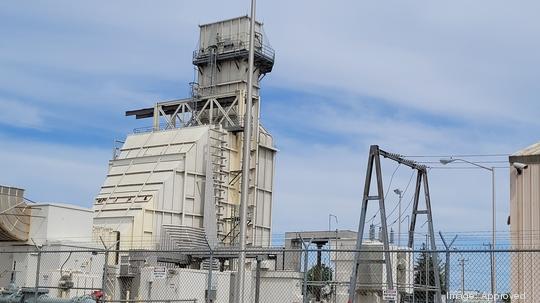
As yet undetermined is what SMUD customers will do over the next eight years. SMUD assumes more existing homes will add solar panels and batteries. It offers incentives, low-interest loans and financing for people to make the conversions.
State law that went into effect in 2020 already requires all new single-family homes to be powered by renewable energy, which usually means solar panels backed by residential batteries.
Last summer, the California Energy Commission unanimously approved mandating that most new commercial construction have solar and battery power. The rule will take effect in January.
SMUD surpassed 50% non-carbon-emitting sources in 2019. The utility is now past 60% renewable sourced electricity.
SMUD, founded in 1946, is the sixth-largest community-owned electric utility in the country. It serves a territory of 900 square miles with 1.5 million people.



